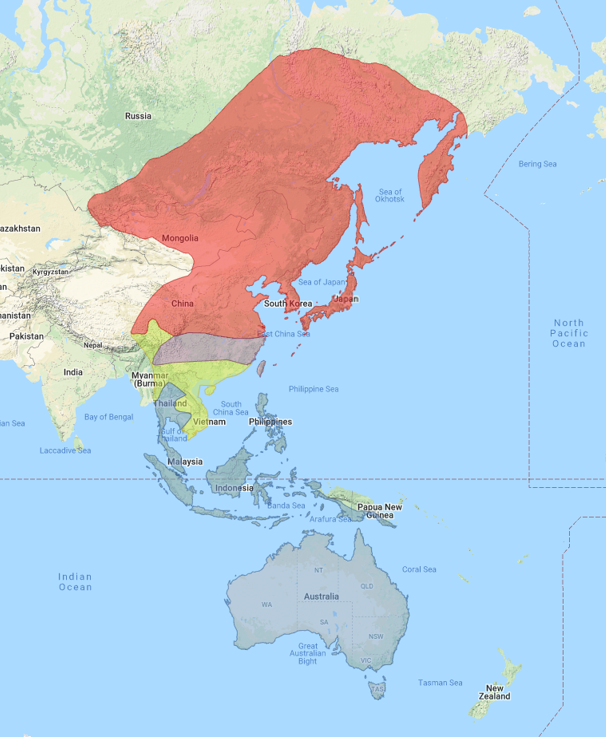Birdfinding.info ⇒ Very common in summer across much of eastern Asia, including Mongolia, adjacent portions of Siberia, Japan, northeastern China (around Beijing), Hong Kong, and Taiwan. During migration periods it can be locally common on the Malay Peninsula and generally along coasts and other prominent landforms throughout Southeast Asia and eastern China. In winter, it is common on Bali and locally in coastal areas of northern and eastern Australia.
Pacific Swift
Apus pacificus
Breeds in eastern Asia. Winters from southern China to Australia.
Breeding. Nests colonially on cliffs and in caves and sinkholes. It has also adapted to nesting under the eaves of buildings like certain swallow species. Breeds from central Siberia (west to Novosibirsk) east to Kamchatka, the Kurile Islands, and Japan, and south to southern China (locally to Guizhou, Guanxi, Guangdong) and Taiwan.
Nonbreeding. Winter range is not well understood due to the recent (2010s) recognition of Pacific and Cook’s Swifts as separate species and the ongoing difficulty of reliably distinguishing them.
Records indicate that northern migrant populations winter over a wide area, from the Malay Peninsula south and east through much of Indonesia to New Guinea and Australia (both west and east, south to Victoria).
Small numbers apparently winter in peripheral areas, including the Philippines and Tasmania.
The localized subspecies kanoi winters farther north, as it is at least partly resident in southern China (Guangdong) and Taiwan.
Movements. Northbound migration is protracted, from February to June, with large numbers arriving in China by March and significant numbers remaining in Australia into April. The distribution of reports suggests that the majority of the population follows the Malay Peninsula, and a minority tracks through the Philippines.
Arrival dates in nesting areas apparently vary from April in parts of China to early June in Siberia, with the bulk arriving in May at sites from Mongolia and central China to Japan.
Southbound migration begins in mid-August and is similarly protracted, with arrivals in Australia reportedly spanning from late August to December.

Pacific Swift, pair at nest site. (Hualien, Taiwan; June 24, 2013.) © WK Cheng
Spring vagrants are somewhat regular (perhaps annual, given that most go undetected) in Scandinavia, Chukotka, and likely throughout the Russian arctic. There have been a few spring records from the Aleutians, Pribilofs, and England.
Fall vagrants are also somewhat regular on the Aleutians, and have occurred elsewhere in Alaska, and in the Yukon, Hawaii (Midway and French Frigate Shoals), the Arabian Peninsula (U.A.E. and Oman), the Seychelles, the Andamans, the Marianas, Palau, the Marshall Islands, the Solomons, New Zealand, Rangatira, and Macquarie Island.
Identification
A large swift with a deeply forked tail, prominent white rump band, and strong scaled “pinecone” pattern on the underparts.
Sometimes holds its tail folded, such that the fork disappears and it looks like a long spike. When the tail is fully spread the fork also disappears.
The face is dark and the throat is usually somewhat paler, often whitish—but can also be gray and not noticeably paler than the face.
Apart from its white rump, the upperparts are generally blackish, usually darkest on the back, lower rump, and tail.

Pacific Swift. (Asinovskiy Rayon, Tomsk, Russia; July 7, 2019.) © Konstantin Samodurov

Pacific Swift. (Lake Furen, Nemuro, Hokkaido, Japan; June 10, 2017.) © Lars Petersson

Pacific Swift. (Lake Furen, Nemuro, Hokkaido, Japan; June 10, 2017.) © Lars Petersson

Pacific Swift, showing pinecone-like vest pattern. (Lake Furen, Nemuro, Hokkaido, Japan; June 10, 2017.) © Lars Petersson

Pacific Swift. (Orkhon Valley, Arhangay, Mongolia; May 30, 2016.) © Frédéric Pelsy

Pacific Swift, with tail folded, but still showing a notch at the tip. (Noosa National Park, Queensland, Australia; November 23, 2018.) © Stephen Murray

Pacific Swift, with tail folded to a single point. (Tinchi Tamba Wetlands Reserve, Brisbane, Queensland, Australia; December 2, 2018.) © Ged Tranter

Pacific Swift, showing deeply forked tail. (Noosa National Park, Queensland, Australia; November 23, 2018.) © Stephen Murray

Pacific Swift, with tail spread, still showing forked shape. (Hong Kong; March 26, 2017.) © Michelle & Peter Wong

Pacific Swift, with tail fully spread, negating forked shape. (Novosibirskiy Rayon, Novosibirsk, Russia; May 26, 2018.) © Konstantin Romanov

Pacific Swifts, showing apparently different throat coloration, possibly due to differences in the lighting. (Lanyu Island, Taitung City, Taiwan; May 8, 2017.) © Lars Petersson

Pacific Swift, showing a white rump band of typical width. (Mount Dos Cuernos, Luzon, Philippines; March 2008.) © Rob Hutchinson
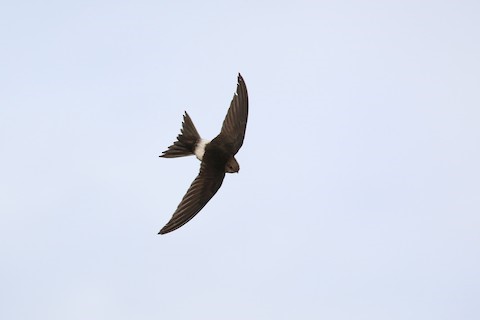
Pacific Swift, showing a white rump band of typical width. (Talbian Ger, Övörhangay, Mongolia; July 17, 2019.) © Oscar Campbell

Pacific Swift. (Table Cape, Tasmania, Australia; November 27, 2019.) © Peter Vaughan
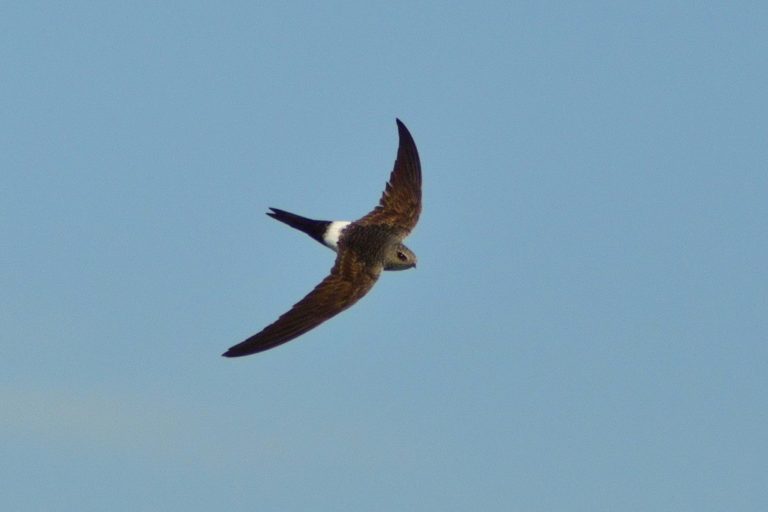
Pacific Swift. (Asinovskiy Rayon, Tomsk, Russia; July 7, 2019.) © Konstantin Samodurov
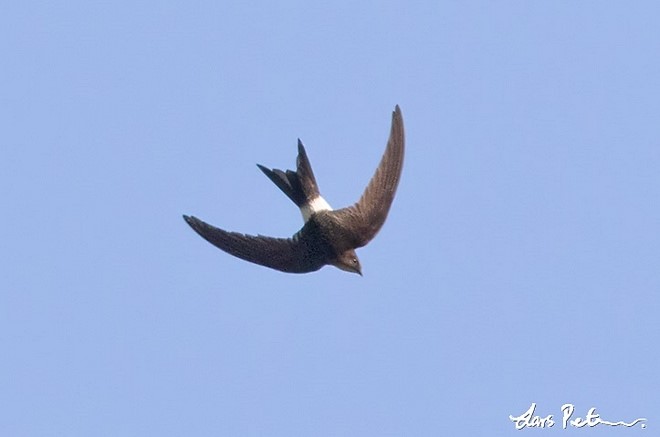
Pacific Swift, showing a white rump band of typical width. (Lanyu Island, Taitung City, Taiwan; May 8, 2017.) © Lars Petersson
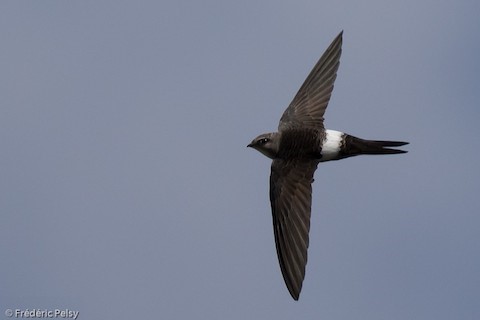
Pacific Swift, showing a white rump band of typical width. (Orkhon Valley, Arhangay, Mongolia; May 30, 2016.) © Frédéric Pelsy

Pacific Swift, showing an apparently thin white rump band. (Lanyu Island, Taitung County, Taiwan; May 20, 2018.) © ST Chien

Pacific Swift, showing an apparently thin white rump band. (Noosa National Park, Queensland, Australia; November 23, 2018.) © Stephen Murray
Cf. Cook’s Swift. Pacific and Cook’s Swifts were traditionally considered conspecific and are very similar. They overlap widely during migration, as Pacific passes through all of Cook’s’ range. Cook’s differs noticeably in two ways: (1) it has a much thinner white rump band; and (2) its underparts have a more boldly contrasting scaled pattern that is essentially black-and-white, as opposed to dark-brown-and-whitish on Pacific. In direct comparison, Cook’s appears somewhat smaller, darker, and shorter-tailed. Vocally, Cook’s appears to differ in giving soft, individual notes (see Mike Nelson, here and here), distinct from Pacific’s screams and trills.
Cf. Blyth’s Swift. Pacific and Blyth’s Swifts were traditionally considered conspecific and are extremely similar. Their ranges do not usually overlap, as Blyth’s breeds in the Himalayas and winters in southwestern India. Blyth’s differs most noticeably in having a slightly thinner white rump band. Its underparts average somewhat darker overall than Pacific’s, especially on the throat. Vocally, Blyth’s appears to differ in giving sharp, choppy notes (see David Farrow, here)—more like chatter than Pacific’s trills.
Cf. Sálim Ali’s Swift. Pacific and Sálim Ali’s Swifts were traditionally considered conspecific and are extremely similar. They almost certainly overlap during migration and winter, as Sálim Ali’s’ breeding range is within Pacific’s migratory range. Sálim Ali’s differs in having a slightly thinner white rump band and a brighter but narrower white patch on the throat.
Notes
Polytypic species consisting of two recognized subspecies. Traditionally considered conspecific with Cook’s (cooki), Blyth’s (leuconyx), and Sálim Ali’s (salimalii) Swifts, known collectively as the Fork-tailed Swift (Apus pacificus), but Leader (2011) persuasively argued for splitting the complex based on consistent differences in morphology and breeding biology, and subsequent research has generally supported this approach.
References
Alderfer, J., and J.L. Dunn. 2014. National Geographic Complete Birds of North America (Second Edition). National Geographic Society, Washington, D.C.
BirdLife International. 2019. Apus pacificus (amended version of 2016 assessment). The IUCN Red List of Threatened Species 2019: e.T22686845A155438660. https://dx.doi.org/10.2305/IUCN.UK.2016-3.RLTS.T22686845A155438660.en. (Accessed October 28, 2020.)
Brazil, M. 2009. Birds of East Asia. Princeton University Press.
Chantler, P. 2000. Swifts: A Guide to the Swifts and Treeswifts of the World (Second Edition). Yale University Press.
eBird. 2020. eBird: An online database of bird distribution and abundance. Cornell Lab of Ornithology, Ithaca, N.Y. http://www.ebird.org. (Accessed October 28, 2020.)
Howell, S.N.G., I. Lewington, and W. Russell. 2014. Rare Birds of North America. Princeton University Press.
Leader, P.J. 2011. Taxonomy of the Pacific Swift Apus pacificus Latham, 1802, complex. Bulletin of the British Ornithologists’ Club 81-93.
Mullarney, K., L. Svensson, D. Zetterström, and P.J. Grant. 1999. Birds of Europe. Princeton University Press.
Pratt, H.D., P.L. Bruner, and D.G. Berrett. 1987. A Field Guide to the Birds of Hawaii and the Tropical Pacific. Princeton University Press.
Pyle, R.L., and P. Pyle. 2017. The Birds of the Hawaiian Islands: Occurrence, History, Distribution, and Status. Version 2 (January 1, 2017). http://hbs.bishopmuseum.org/birds/rlp-monograph/. B.P. Bishop Museum, Honolulu, Hawaii.
Robson, C. 2002. Birds of Thailand. Princeton University Press.
Xeno-Canto. 2020. Pacific Swift – Apus pacificus. https://www.xeno-canto.org/species/Apus-pacificus. (Accessed October 28, 2020.)

